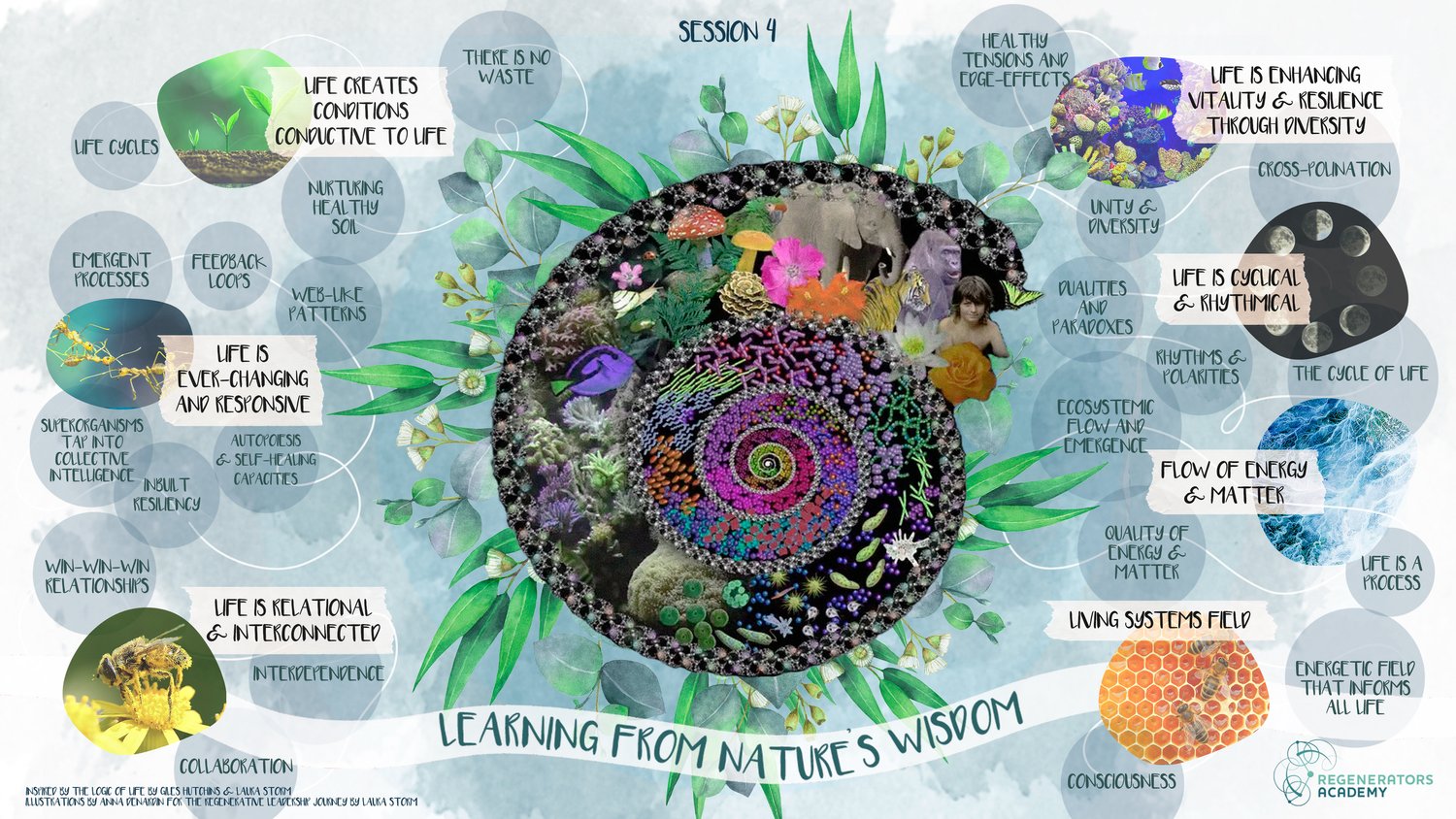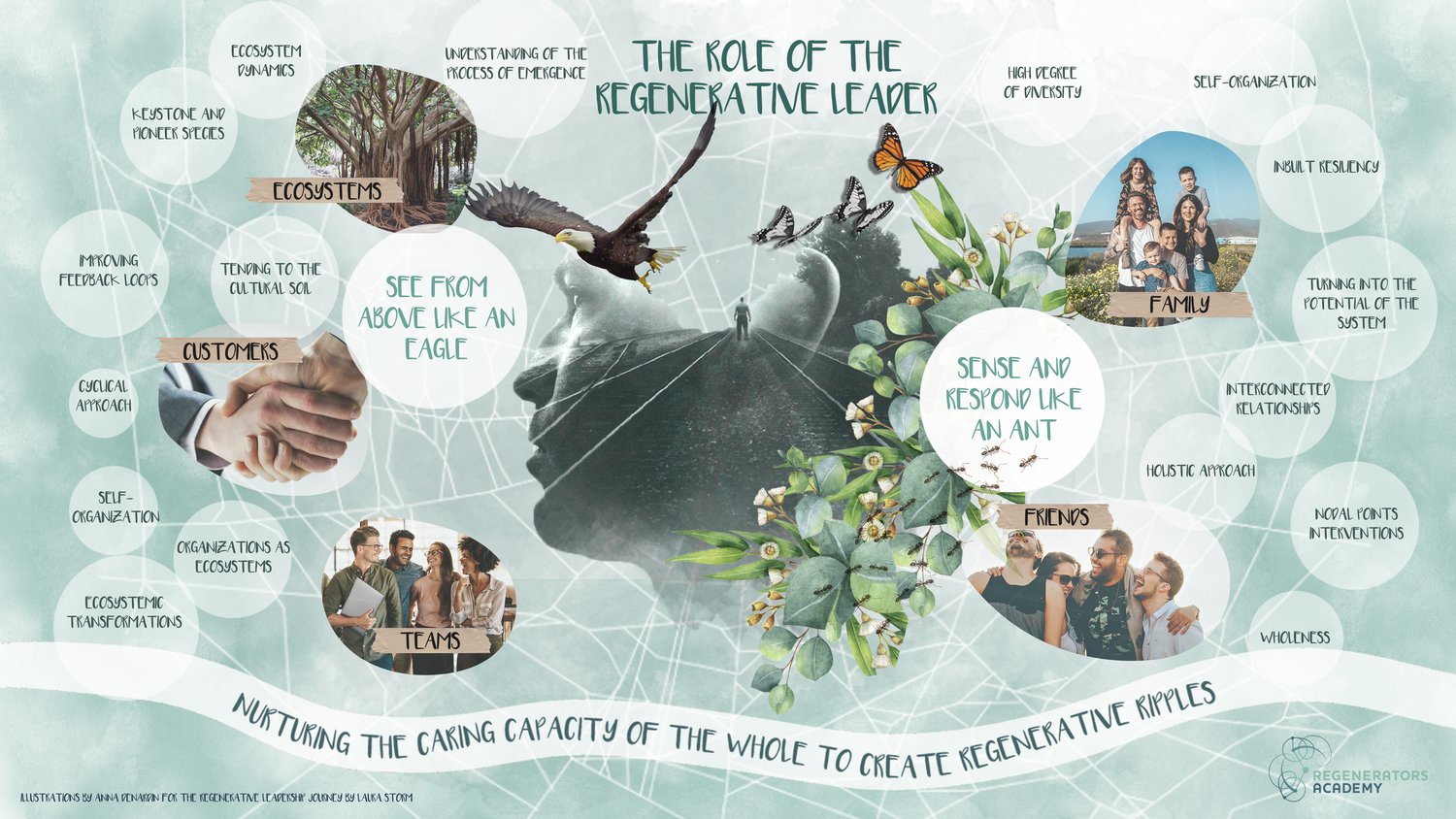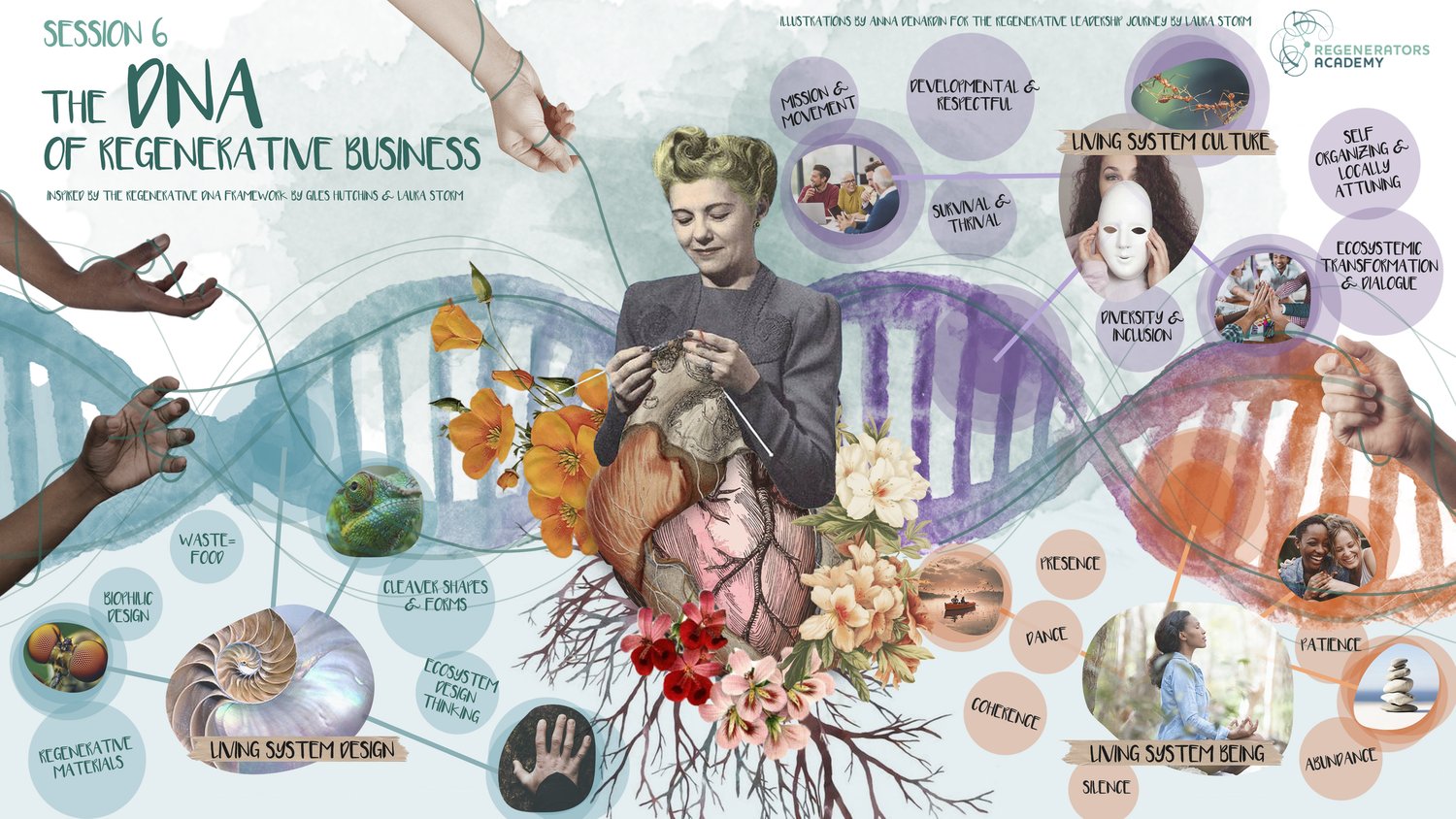Regenerative Leadership … Hamdi Ulukaya’s greek yogurt to Mate Rimac’s supercars, Tom Szaky’s loops and Eva Karlsson’s take backs … leaders with a more enlightened approach to developing the future business, inspired by the principles of living systems and nature
February 26, 2025

In a world grappling with environmental degradation, societal disconnection, and systemic disruption, the dominant model of business leadership is proving inadequate.
Traditional leadership often emphasises control, efficiency, linear growth, and profit maximization. This mindset encourages a blinkered approach, to drive profit at all costs. Short-term, yes, and also without caring about the external costs of achieving it (the costs to nature, and society).
But a new paradigm is emerging.
Rooted in living systems thinking, inspired by the intelligence of nature, and focused on creating conditions for life to thrive, regenerative leadership offers a path forward. It invites leaders to reimagine business as a force not just for minimizing harm, but for regenerating people, planet, and profit simultaneously.
So what is regenerative leadership?
Regenerative leadership is a way of leading that’s inspired by the principles of living systems and nature. Instead of trying to control or extract from the world, regenerative leaders work to create conditions for life to thrive—within their organisations, communities, and ecosystems.
Regenerative leaders seek to reinvent business as a force for good. It can still be about growth and profitability, but in a more enlightened way. In a way that gives more than it takes – becomes net positive, rather than net zero – and creates value for shareholders, and all other stakeholders too.
At its core, regenerative leadership is about shifting from a mechanistic, exploitative mindset to a holistic, life-centered approach. It focuses on restoring and enhancing the health of people, planet, and systems while still delivering profitable growth. It’s not just about doing less harm—it’s about actively doing good and contributing to regeneration.
Leading business as a living system
For much of the industrial era, organizations have been treated like machines—predictable, hierarchical, and controllable. This mechanistic worldview has led to rigid structures, siloed thinking, and a short-term focus on outputs and efficiency. Regenerative leadership, in contrast, draws inspiration from nature, recognizing that organizations are living systems embedded within larger living systems—ecosystems, societies, and economies.
Living systems thrive through diversity, decentralization, reciprocity, and resilience. They are dynamic, self-organizing, and constantly evolving. Leaders who adopt a regenerative mindset understand that business must align with these natural principles if it is to remain viable in the face of accelerating change. Regenerative organizations are not merely sustainable; they are life-enhancing, contributing positively to the systems in which they operate.
These ideas are brilliantly articulated in the book

The core of regenerative leadership
Regenerative leadership begins with a shift in consciousness—from separation to interconnection. It asks leaders to move beyond ego-centric to eco-centric thinking. Rather than seeing the organization as an island, leaders recognize it as part of a larger web of relationships and responsibilities. This shift reshapes decision-making, strategy, innovation, and culture.
Several core principles define regenerative leadership:
-
Purpose Beyond Profit
Regenerative businesses are animated by a deep sense of purpose that extends beyond financial returns. They seek to serve life, not extract from it. Profit is seen as a means to sustain and scale impact, not the end goal. This shift unlocks intrinsic motivation among employees, fosters trust among stakeholders, and builds brand resilience. -
Systems Thinking
Regenerative leaders see the bigger picture. They cultivate the ability to zoom out and understand the interdependencies within and beyond their organizations. This systems awareness helps leaders anticipate unintended consequences, design holistic solutions, and foster innovations that ripple across sectors and scales. -
Resilience and Adaptability
Inspired by nature’s capacity to adapt, regenerative leaders build organizations that are resilient to shocks and capable of evolving. They design with change in mind—embracing uncertainty, learning from feedback, and investing in decentralized structures that empower teams and communities. -
Inner Development
Regeneration starts from within. Leaders must undergo personal transformation to lead system-level change. This includes cultivating emotional intelligence, humility, empathy, and presence. Regenerative leadership is not just about strategy; it’s about being—showing up with authenticity, curiosity, and care. -
Co-creation and Inclusion
Nature thrives through collaboration. Likewise, regenerative leadership is relational, not transactional. It honors diverse voices, fosters deep listening, and builds partnerships across boundaries. Stakeholder inclusion—especially those historically marginalized—is essential for developing truly regenerative solutions. -
Integration of Regenerative Design
A regenerative business designs its products, processes, and places in ways that restore ecosystems and communities. From circular supply chains and regenerative agriculture to buildings that sequester carbon and workspaces that nourish wellbeing, the design choices reflect a commitment to healing and renewal.

Examples of regenerative leaders in business
Here are some of the best known regenerative business leaders, CEOs and founders who are reshaping business not just to minimise harm, but to restore ecosystems, empower communities, and create long-term systemic value:
- Hamdi Ulukaya: the Turkish immigrant entrepreneur founded greek yogurt business Chobani as a force for social regeneration – hiring refugees, supporting rural economies, and pushing for ethical capitalism. Key initiatives included profit-sharing, inclusive hiring, local supply chains, food equity programs.
- David Perry: founder of Indigo Agriculture, built a company helping farmers adopt regenerative agriculture while tracking carbon sequestration and rewarding ecosystem services. His key initiatives include a carbon farming marketplace, microbial seed coatings, farmer-centered impact metrics.
- Tom Szaky: a circular economy entrepreneur designing reuse and refill systems for global brands to move beyond single-use packaging. His businesses are TerraCycle and Loop, with a reusable packaging platform, recycling hard-to-recycle waste, closing resource loops.
- Yvon Chouinard: Chouinard built Patagonia on environmental ethics, but went further by making the Earth its “only shareholder” in 2022. The company invests profits in regenerating nature and fighting climate change. His key initiatives included regenerative organic cotton, Worn Wear (circularity), environmental grants.
- Emmanuel Faber: Faber pushed Danone to become the world’s first large multinational to adopt “Entreprise à Mission” status, integrating social and environmental purpose. His iconic projects included regenerative agriculture programs, B Corp certifications, climate-forward dairy sourcing.
- Paul Polman: the Dutch CEO transformed Unilever’s business model toward sustainable living, prioritising stakeholder capitalism and long-term planetary health. And famously refusing to be a salve to quarterly returns. Key projects included the Sustainable Living Plan, carbon-positive operations, inclusive value chains.
- Eva Karlsson: CEO of Swedish brand Houdini Sportswear, leads with circularity, ecological innovation, and transparent product development rooted in planetary boundaries. Key initiatives included full product take-back system, climate-positive operations, regenerative design labs.
- Mate Rimac: Founded of Rimac Automobili, based in Croatia, makes electric supercars and champions clean mobility and circular engineering as ways to regenerate transportation systems. His projects include electric drivetrains, closed-loop manufacturing, future mobility ecosystems.
These leaders share traits like systems thinking, deep ecological awareness, long-term orientation, and a drive to serve life, not just shareholders. Of course, in a business context, generating profitable returns still matters.
Yvon Chouinard sold his entire Patagonia business to a non-profit foundation, through which every cent of earnings goes to fighting climate change. Financial success therefore leads to positive impact. At Danone, Emmanuel Faber was less successful. While developing a fabulous transformational plan, he failed to recognise the need to also deliver short-term returns, and lost his job. You need to do deliver short and long-term, financial health and a better world
Leadership practices for regeneration
Regenerative leadership is not a fixed set of actions but a living practice. It requires continual reflection and adaptation. However, there are practices that help leaders embody this new way of leading:
-
Nature Immersion: Regular engagement with nature cultivates presence, perspective, and inspiration. It reminds leaders of their place in the web of life and offers direct insights into living systems.
-
Deep Listening and Dialogue: Regenerative leaders create spaces for meaningful conversation. They ask powerful questions, listen beyond words, and make room for silence. Dialogue becomes a source of collective wisdom and emergence.
-
Biomimicry and Nature-Inspired Innovation: By studying how ecosystems solve complex problems, leaders can innovate more sustainable and efficient processes. For example, decentralized water systems modeled on root networks or governance inspired by the behavior of social insects.
-
Regenerative Metrics: Moving beyond KPIs focused solely on revenue or efficiency, regenerative leaders embrace metrics that track impact on soil health, biodiversity, community wellbeing, and employee flourishing. These holistic indicators better reflect the health of the whole system.
-
Ritual and Rhythm: Just as nature follows rhythms—seasons, cycles, pulses—regenerative leadership honors the natural rhythms of people and teams. This includes respecting rest, reflection, and renewal as essential to creativity and performance.
Business as a living organism
Organizations that adopt regenerative leadership begin to behave less like machines and more like ecosystems. Patagonia, for example, has built a culture rooted in environmental activism and regenerative agriculture. Interface, the modular flooring company, shifted its entire business model to “reverse climate change,” integrating biomimicry and circular economy principles into everything it does. These companies demonstrate that regeneration and profitability are not at odds—when done authentically, they reinforce each other.
The regenerative business sees its role not as dominating the marketplace but as stewarding the future. It contributes to local communities, replenishes ecosystems, and builds long-term social equity while also creating economic value. This is not altruism—it’s strategy. As markets become more volatile and stakeholders demand more accountability, regenerative businesses are positioned to lead.

The leadership we now need
The challenges of our time—climate disruption, biodiversity loss, inequality, burnout—are not isolated problems. They are symptoms of a deeper crisis in how we lead and live. Regenerative leadership meets this moment by returning to timeless truths. Nature has 3.8 billion years of experience in creating thriving, resilient systems. Rather than trying to dominate nature, it’s time we learn from it.
This is a radical act—not in a destructive sense, but in the original meaning of radical: going to the root. Regenerative leadership invites us to reconnect with our deepest values, our highest aspirations, and the living systems we are part of. It asks us to lead not just for today, but for seven generations to come.
In doing so, we can transform business from a source of extraction to a source of regeneration. We can build companies that heal rather than harm, that enliven rather than deplete. And in this transformation, we not only reinvent business—we reinvent ourselves.
More from the blog